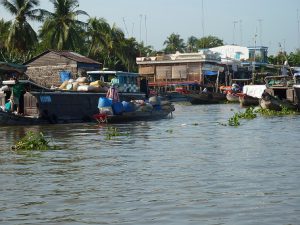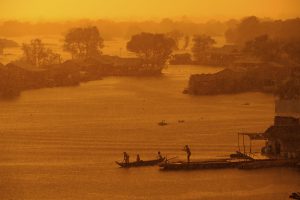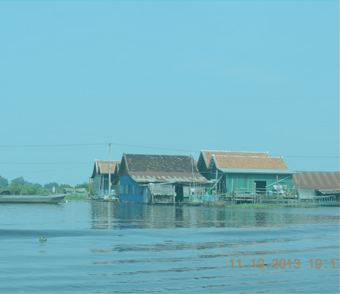NHI’s Accomplishments
The Natural Heritage Institute (NHI) and an international team of experts, funded in part by USAID, have evaluated proposed and existing hydropower projects in Lao and Cambodia that will have major negative impacts on Mekong River fisheries. The team has developed, in detail, innovative alternatives to dams and dam operations that both protect fisheries and provide power benefits. The proposed alternatives are being evaluated by the governments of Lao PDR, Cambodia, and Vietnam.
Problem Statement
The Mekong River in Southeast Asia is one of the most important and productive natural systems in the world. Originating in the Tibetan Plateau, it flows 4,800 km through six nations – China’s Yunnan Province, Myanmar (Burma), Lao PDR, Thailand, Vietnam and Cambodia – before forming a complex delta system with several distributaries and entering the South China Sea. It provides more food than any other river and is second only to the Amazon in its biodiversity. The Mekong is also one of the most threatened in the world.

Approximately 48 major dams, some the largest in the world, are now operating or inevitable, in the Mekong. Another 71 are in prospect. Some of these dams will meet essential domestic power needs, but most will generate revenues through power exports. The epicenter of development is Lao PDR and Cambodia, which is being driven by investments from China and Thailand. On the mainstream of the Xe Kong River, the last free-flowing tributary of the Mekong, feasibility studies for eight large hydropower projects are currently underway by private investors under authorization from the governments of Lao and Cambodia. According to the current designs, NONE of these dams would be able to pass migratory fish, sediments or nutrients. The Mekong River is characterized by a very high percentage of long-range migratory fish. The sediments define the morphology—the physical shape–of the River and its floodplains and delta. This physical substrate determines the quality and variety of the habitats, which, in turn, determine the biological productivity of the system. The associated nutrients nourish the food web, which engenders the amazing biological productivity of the Mekong.
The Mekong dams present insurmountable barriers to the 87% of the Mekong fish species that must move from the ocean, the delta and Tonle Sap up into the large tributaries coming out of Lao, Cambodia and Vietnam to complete their life cycle and reproduce successfully. The Xe Kong portion of the Mekong is the most important for migratory fish production and for contributions of sediments and nutrients that replenish and maintain the habitats that support an extraordinary ecological bounty. They would convert this free-flowing river into a series of sterile impoundments and—quite literally—kill the most productive river in the world. These are flows that nourish the life of the Mekong River and the 70 million people who depend on it intimately for sustenance, transportation, livelihoods, and cultural enrichment.
It is a stark reality that, under current dam development plans and operations, approximately 94% of the sediments and nutrients that now maintain the Lower Mekong will be captured and taken out of the system over the coming decades. This will fundamentally undermine the exceptionally diverse habitats that make the Mekong the most productive river in the world.

The combined effects of sediment deprivation and sea level rise from global climate change have the potential to create a humanitarian crisis of unprecedented proportions. The Mekong delta has been designated by the Intergovernmental Panel on Climate Change as one of three mega deltas (with more than 1 million people) most threatened by coastal erosion due to sea level rise, along with the accompanying storm surges and salinity intrusion. Some 30% of this delta may be permanently lost. But the fate of the remaining 70% depends on maintaining the inflows of sediments and nutrients, and the annual flood pulse that replenishes the delta landscape and the near shore marine environment.
And, the delta is not the only graphic example of the potential impairment. Actually, the productivity of the entire river system, its floodplains, the magically productive Tonle Sap Great Lake (the most productive freshwater lake in the world), the deep holes in the river bottom, the marine fishery, the 32 biological “hotspots”, indeed, every element that accounts for the extraordinary productivity, will be degraded. Most of this can be saved, IF the sediment processes can be maintained in the face of massive upstream development.
Project Objectives and Components
The fate of the river, its people, and its most biologically productive features – such as the 3-S basin, the Tonle Sap Great Lake, the Cambodian floodplains, and the delta – will largely be determined within the next 3-5 years. To counteract or prevent the expected physical changes to the Mekong River system and to help shape the course of development, NHI has been leading an ongoing set of partnerships since late 2010 with the Lower Mekong Basin national governments, the Mekong River Commission, and USAID[1] to formulate and assess more environmentally compatible alternatives for siting, designing and operating hydropower dams in the Mekong River Basin. There are two active components:
The objective of the Project is to maintain the natural functions of the Mekong River, especially of the last intact remnant – the Xe Kong tributary – by informing the choices that will be made by the national governments, investors and hydropower customers with regard to the siting, design and operation of hydropower dams throughout the Lower Mekong River system. For these imminent decisions, it is essential to make the case directly to decision-makers, and the the information that will speak most eloquently is technically credible information regarding the alternatives that will preserve most of the hydropower potential while avoiding the adverse impacts on the downstream ecosystems, the people that depend upon them, and on the economic lifespan of the reservoirs.
A keystone of the sustainable power development alternatives submitted to the Governments of Cambodia and Lao PDR is an exciting innovation that has global ramifications. This is the concept of augmenting power output from existing hydropower reservoirs by deploying floating solar photovoltaic arrays that would be fully integrated into the hydropower project. The Sambor Dam would be replaced by such a hybrid facility on the Lower Se San 2 reservoir, which is now built and has already exacted its (regrettably large) environmental toll, while in Lao PDR the solution is to “hybridize” the largest reservoir in the basin, the Xe Kaman 1 reservoir. This feasibility study is being undertaken with the full cooperation and collaboration of the Viet Lao Power Joint Stock Company (VLPJSCo), the Vietnamese firm that owns and operates Xe Kaman 1. The resulting hybrid power facilities could approximately double the output while also improving firm power reliability and greatly reducing financial risks to the investors. In addition, they would position Cambodia and Lao to be a global leaders in this new technology, and teach the rest of the world how to do it.
NHI is also working with the Government of Vietnam at the highest technical levels to inform them of the hydropower alternatives available to Lao and Cambodia to keep sediment and fish flowing. NHI can only illuminate the best and most sustainable hydropower development alternatives for the national governments and hydropower developers; it cannot itself implement these solutions. Thus, to advance the likelihood that these governments will choose the best course of development, it is important to equip the downstream riparian countries like Vietnam that will feel the impacts of untoward choices—with information in order to raise their voice in an effective manner.
Results and Expected Outcomes
The overall project goal is to fundamentally transform the current development plans in the Lower Mekong Basin with more benign alternatives. NHI presented final reports that contain these alternative strategies to the Governments of Cambodia and Lao PDR in late 2017 and early 2018, respectively. They supplant the need for new dams, thereby protecting the Mekong fishery and keeping sediment and nutrients flowing to the delta, which are necessary to prevent the delta from disappearing completely due to climate change. NHI is shifting the way governments think about their options to meet their countries’ energy needs while taking climate-smart action that protects environmental resources and human livelihoods. (Click on the Lao and Cambodia links above to read more about the specific results and recommendations.)
Project Team
NHI assembled an impressive technical team comprised of NHI Affiliates who provide top expertise in hydrological modeling, hydropower engineering, sediment management, fish biology and fish-passage, and international project management. They work collaboratively with their counterparts at national government agencies and research institutes, and also provided training and knowledge transference. Currently, the NHI Team is providing ongoing technical support for the governments of Lao and Cambodia in their consideration of implementing NHI’s recommendations.
Natural Heritage Institute – Project Coordinator
Key Members of the NHI Technical Team:
- George Annandale (dam engineering and sediment management)
- Martin Mallen-Cooper (fish by-pass expert)
- Peter Meier (hydropower economist)
- Thomas Bernard Wild (hydrologic and sediment modeling)
- Erland Jensen (Cambodia representative: fisheries, informatics and M&E expert)
- Lilao Bouapao (Lao national and Project Assistant/Translator)
- Symonekeo Sensathith (Lao PDR Government Relations Associate)
- SERIS – Solar Energy Research Institute of Singapore
Cooperating Agency:
- Mekong River Commission (MRC)
National Counterpart Organizations
- Cambodia:
- Ministry of Water Resources and Meteorology (MOWRAM)
- Ministry of Mines and Energy (MME)
- Ministry of Environment (MOE)
- Inland Fisheries Research and Development Institute (Fisheries Administration of Ministry of Agriculture) (IFREDI)
- Lao PDR:
- Ministry of Water Resources and Environment (MONRE)
- Ministry of Energy and Mines (MEM)
- Ministry of Planning and Investment (MPI)
- Living Aquatic Resources Research Center (Ministry of Agriculture and Forestry) (LARREC)
- National University of Lao
- Vietnam:
- Institute for Hydrology, Meteorology and Environment (IMHEN) within the Ministry of Natural Resources and Environment
- Southern Institute for Water Resources & Planning (SIWRP) within the Ministry of Agriculture and Rural Development
[1] Project funding provided by USAID, the MacArthur Foundation and the Margaret A. Cargill Foundation.

